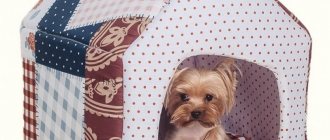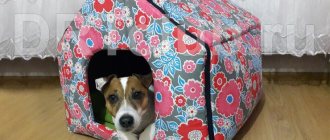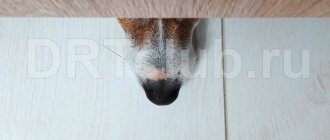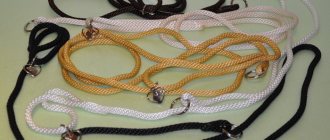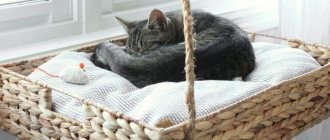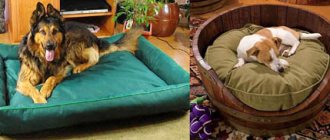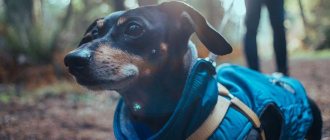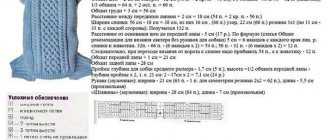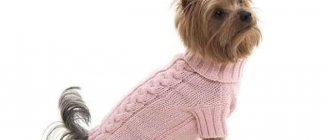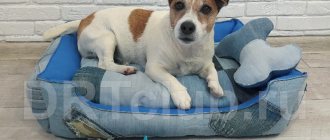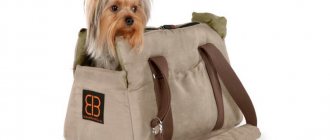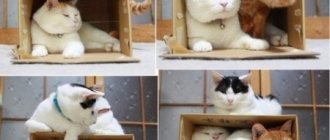In inclement weather, people bundle up in warm, comfortable, waterproof clothing that is comfortable and in line with fashion trends. Our faithful, devoted little brothers - dogs - suffer no less than us from heat, wind, and bad weather. Being responsible for those who were taken into the family and tamed, we take care of our four-legged friends, worrying about their health and well-being. Do-it-yourself clothing for dogs, the patterns of which are modeled taking into account the parameters of your pet, will warm you up in cold weather, hide you from the rain, and highlight your pet’s stylish, fashionable “outfit.”
Let's look at the main types of clothing for small dog breeds
Functional clothing
– things used for autumn-winter-spring walks: these are jackets made of light but waterproof material, warmer fur coats or down jackets, as well as safety shoes.
Decorative clothing
– it includes things that do not carry any functional load, but serve for purely aesthetic purposes. These are various dresses, blouses, pants, T-shirts and other things that, in their assortment, are close to the human wardrobe.
Buying ready-made clothes for your pets or sewing them yourself is a matter of taste and wallet for each individual owner. This article will talk about how to sew clothes for your dog without spending a large amount of money, because you can use your old boring things, such as a jacket or jeans.
Let's look at how to sew clothes for a dog using a pattern, using the example of a sports overall for a Chihuahua. For work we will need: a sheet of paper, fabric (preferably cotton or knitted velor), threads in the color of the fabric, a sewing machine (you can do without it - the overalls are not large), rhinestones or other decorations at your request.
Sewing tips
So, you finally decided to sew clothes for your pet yourself, rather than buying expensive and faceless dog clothes in the store. It’s wonderful, because hand-sewn clothes will make your four-legged friend individual, and your little pet will definitely appreciate such care for him. How to sew clothes for a dog using patterns?
Small dogs should be measured as follows:
- first of all, we measure the length of the pet (along the back) from the withers to the tail;
- then we measure the height of the paws from the floor to the dog’s sternum;
- then you need to measure the dog’s belly;
- Next, measure the length from the dog’s neck to its groin (this size will depend on the gender of the pet);
- The last thing to measure is the animal’s body and its circumference.
The measurements have been taken, the next stage will be making patterns and sewing clothes. The process of creating patterns and modeling clothes is very important.
This will require considerable perseverance and attention. You can look for diagrams and patterns in this article
Below you will find what you need. The article contains not only photos, master classes, but also a video on how to sew clothes for small dogs.
1) Pattern of overalls with a hood for a Chihuahua:
2) Clothes for Yorkies:
3) Pattern of shoes for toy terriers:
The choice of fabric for sewing clothes for a pet depends on seasonality. It must be remembered that summer is diametrically opposed to winter. For winter clothes, it is better to choose warmer materials; it would be useful to use insulation (sintepon).
Spring and autumn clothing should be waterproof and repel dirt well.
Remember, tailoring clothes for dogs is impossible without high-quality accessories: buttons, zippers, Velcro, hooks and fasteners. The fittings must be strong and beautiful.
Stages of sewing overalls for a domestic dog using patterns
First, we make a pattern on paper, if necessary, adjusting it according to the size of your dog. To construct this pattern, a 2*2 cm cage is used, the length of the dog’s back is 22 cm.
At this stage, it is important to correctly construct all the clothing patterns for the dog, and several nuances must be taken into account: the gender of the animal, the volume of fur, skin folds, nails, tail, freedom of movement. It is also important to take into account the characteristics of each specific breed: for example, when sewing clothes for Yorkies, you need to make an allowance for freedom of movement, taking into account the volume of fur, and in clothes for a French bulldog there should be a wider neck, since dogs of this breed have a thick and massive neck .
We cut out the finished pattern and transfer it to the fabric, leaving 1 - 2 cm for allowances, taking into account all the features of your dog. We sweep the product along the seams and try the overalls on the dog. After we are convinced that it is in season and the animal feels comfortable in it, we finally sew it together. Glue rhinestones, sew on stripes or other decorations that you have prepared. The end result should be a suit like this.
By analogy with this costume, you can sew several more models of clothing for a Chihuahua (for example, a raincoat or a poncho with a hood). Dogs of this breed have delicate skin and quickly lose heat, so to protect against scratches, it is recommended to wear it at all times, regardless of the weather.
Warm clothing is also necessary for dog breeds such as the Chinese Crested and Toy Terrier. The fact is that the Chinese Crested has practically no hair, and the Terriers have no undercoat, as a result of which these dogs almost constantly freeze, even in an apartment.
We sew overalls for dogs from an old jacket
If there is an old children's jacket in the house, then there will be no problems converting the item into overalls for the dog. Especially when the size of the dog is almost identical to the parameters of the jacket. This is usually how they make their own clothes for a Spitz. An example of a overalls pattern from an old jacket:
Overalls pattern
Any small dog requires care, including being warmly dressed for walks. To do this, you can buy clothes or sew (knit) them yourself. There are a lot of step-by-step instructions, according to which you can make different outfits for your pets.
We are trying to study popular types of shoes for small breeds
In addition to clothing, in winter small breed dogs also need shoes to protect their paws from glass shards, debris and chemicals that are sprinkled on city streets. Shoes, like clothes, can easily be made from old things, such as a woolen jacket. The sole is usually made from genuine leather, suede or other waterproof materials. Winter shoes are usually lined with fur, padding polyester, fleece or other insulating materials. In order for the boots to stay securely on the paws, Velcro, buckles, and elastic bands are used.
As an example, I suggest looking at a few photos with shoe options for your pets, which you can make yourself:
Necessary materials
To make the jumpsuit I used the following materials:
- Membrane fabric with water protection.
- Lining fabric on padding polyester (lining stitch). Depending on how warm or not you want the overalls to be, you can use a thinner fabric (for example, flannel, fleece) as the lining layer. If you plan to use the overalls in severe frosts, then as an additional insulating layer you can use Alpolux insulation, which is quite frost-resistant.
- Tractor lightning. If you sew a zipper only along the back (without a collar), as I did, then the length of the zipper must be exactly the same as the length of your pet’s back (in my case it is 30 cm). If you plan to “extend” the zipper to the end of the collar, then its length should accordingly be greater.
Jack always wears collars with us. If I had sewn a zipper along the entire length of the overalls, including the collar, then I would have to put Jack's collar on top of the collar. After all, if I wore the collar down, the leash would constantly rub against the collar, but I don’t think that’s very comfortable. In my opinion, the long lock option is suitable if your pet wears a harness.
How to make clothes for dogs with your own hands?
Before getting a dog, you should definitely think about whether you are ready to provide it with proper care. This applies not only to food, walks and visits to the veterinarian, but also to the purchase of special clothing. Indeed, in the modern world it is considered an essential element of keeping a dog. However, even with minimal sewing or knitting skills, you can make such clothes with your own hands.
Where to begin
You need to start by studying some of the features of clothing for dogs. If you devote enough time to this, as a master, there will be no price for you. In pet stores today there is quite a wide selection of different models of clothing for dogs, but most often they are sewn without taking into account the anatomy and some of the features of our smaller brothers. For example, a jumpsuit designed for a long-haired dog should not have elastic bands on the legs (they tangle the hair), the hood on the jacket should not have ties, preferably buttons or Velcro - there are quite a lot of such little things.
To understand everything, look through “dog” forums, topics about clothes
Just not those where they sell, but those where the owners discuss the things they bought, pay attention to what they praise and what they are dissatisfied with
Non-professional seamstresses, when creating clothes for their own pets, often share patterns on the Internet; you can also download several books with tips on cutting and sewing clothes for dogs, with ready-made models and step-by-step instructions on how to make them. The more of this material you have on hand, the better. When you gain experience, you will create clothing models yourself; it is not as difficult as it seems. But for starters, ready-made pattern diagrams will be very useful to you. You can improve your skills by sewing several different models of clothes for the dogs of your relatives or friends; they will probably be happy to help you, and in return they will receive a cool thing as a gift.
How to take measurements correctly and choose material?
The choice of material depends on what weather you are going to make clothes for. For example, for walking it is very important to choose fabrics that are easy to care for and wash. Due to this, its service life will be significantly longer.
For the autumn season, it is better to take a closer look at a single-layer material that will protect the wool from slush and dirt. This is especially true for dogs with long hair or dwarf dogs.
In the winter season, the task of clothing is somewhat different. Therefore, it must have insulation. For example, padding polyester, padding polyester or fleece. Such products are in demand among owners of small and smooth-haired dogs.
In general, it is believed that it is better to choose cotton from natural fabrics, and microfiber, polyester and viscose from artificial fabrics. Satin and silk are suitable as lining, as they prevent the wool from tangling.
As for the measurements, it's actually not difficult to do. The main thing is that the animal is in a standing position and only on a flat surface. Also, different measurements may be needed for sewing products, so pay attention to the photo.
The meaning of all the measurements shown in the picture:
- The length of the back is the distance from the withers to the base of the tail.
- Neck girth suggests that you need to take measurements at the widest point on the neck. This can be done simply by measuring the collar.
- The chest circumference is also measured at its widest point.
- Waist circumference.
- Belly length for females.
- Chest width (distance between the bases of the humerus).
- The length of the front legs is measured exclusively from the base.
- The length of the hind legs should be measured using the same principle.
- Belly length for males.
- The distance between the ears for sewing a headdress.
- Head circumference.
- Muzzle circumference.
How to sew a windbreaker for a dog (instructions with pattern)
To do this you will need the following materials:
- Warm fabric
- Elastic band (“elastic band”)
- Elastic cord, two tips and a clamp for it
First, we take measurements and make paper patterns, only then we move on to sewing.
How to take measurements
- The volume of the neck is measured at its base, at the widest part. Always add about 2 cm to this figure so that the dog can breathe freely.
- The length of the neck is the distance from its base (the widest part) to the top of the head.
- Chest girth is measured at the widest part of the chest, just behind the front legs. You also need to add about 2 cm to this indicator (for very fluffy dogs - 3 cm) so that the animal does not feel tight in clothes.
- The length of the sternum begins at the shoulder blades and ends behind the rib cage, where the dog's torso begins to taper.
- Waist circumference is measured at the narrowest part of the torso, between the chest and hips.
- Back length is the distance from the base of the neck between the shoulder blades to the base of the tail.
- The length of the leg is equal to the distance from the lower edge of the shoulder blade (where the leg meets the torso) to the floor.
- The girth of the leg is measured at its base (the place where the leg meets the torso).
Body pattern:
1. Draw a rectangle that is the length of your dog’s back and the width of ½ the circumference of his chest.
2. Mark the length of the sternum (A) on the rectangle
3. Mark the center of the rectangle in height (B)
4. Draw a smooth curve from A to B. In the figure, the curve that is more suitable for female dogs is marked in pink. The curve more suitable for the male sex is marked in blue.
5. Mark ½ of the circumference of the neck (C) and a point about 1 cm (a little more or a little less, depending on the size of the dog) from the edge of its long side (D). Connect both points with a smooth line.
6. The opening for the sleeve should be slightly narrower than the circumference of the neck, but at the same time be free enough for the dog to move around without interference.
Sleeve pattern:
in the top picture on the left
1. Measure your dog's feet
2. Draw a rectangle whose length is equal to the length of the leg and the width is half of it.
3. Draw a smooth curve at the top of the rectangle according to your leg circumference
4. Leave a small seam allowance on the right side and along the top edge of the pattern (the left and bottom will not be needed)
Hood pattern (in the picture on the right):
in the top picture on the right
1. Measure your pet's neck circumference
2. Draw a rectangle using the length of the neck and ½ its circumference for the length and width of the piece, respectively.
3. Slightly round the top right corner of the rectangle
4. Leave a small seam allowance along the bottom, left and right sides of the piece. Don't add anything at the top.
5. Mark the places where the hole for the lace will be
6. Fold the piece of fabric in half, wrong side out. Attach paper patterns to it, as shown in the photo, secure with sewing pins and cut out all the parts of the future windbreaker. Finish the edges of the fabric with an overlock or zigzag stitch.
Having completed the described manipulations, you can proceed directly to sewing the windbreaker. It consists of three stages:
Sleeve stitching
1. Wrap the rubber band around your leg, directly at the paw, to measure the girth of the cuff. Allow a small allowance as the tape will shrink a little when stitched to the fabric. Cut the resulting piece, and then another one of the same length.
2. Lay out the sleeve pattern on a flat surface, wrong side up. Stretch the elastic so that it matches the width of the fabric on the side where the cuff will be. Pin it to the pattern, about 1 cm from the edge, and stitch it in a stretched state with a zigzag so that it remains elastic. When you release the elastic, the fabric will bunch up. Do the same with the second sleeve.
3. Fold the bottom edge of the sleeve so that the elastic remains inside, stretch the pattern again and sew only the fabric. You should have a simple cuff.
4. Fold the sleeve in half lengthwise and stitch the edges.
Sewing the hood and body
5. Hem the fabric on the flat (not rounded) side of the pattern by 2 cm. You will thread the lace into this cuff.
6. Fold the rectangle in half and stitch the edge opposite the drawstring cuff.
7. Turn the hood inside out and thread the drawstring through the cuff. Place the clamp and lugs on it.
Sewing the sleeves and hood to the body
8. Fold the rectangular body pattern in half, wrong side out, and stitch the edges between the sleeve holes. Sew the sleeves and hood to the corresponding holes and turn the windbreaker right side out. And now your jacket is ready!
DIY clothes for small dogs
Sewing clothes for small dogs can be a little more difficult, as there will be small details. But nevertheless, if everything is done correctly, the result will be worthwhile.
Dachshund blanket
Despite the fact that dachshunds are hunting dogs, they definitely need clothing. Especially in cold and rainy weather, the lower part of the body freezes very quickly. Therefore, a blanket is an ideal option that does not hinder movement. Even if your dog is not accustomed to wearing clothes, putting on this product will be very simple and quick.
Overalls for Yorkshire Terrier
To create a cute onesie for your dog, choose a suitable, high-quality material and prepare measurements. This type of clothing is best suited for cool weather.
Please note that the pattern consists of four parts. Their sizes will depend on the measurements of your terrier. Therefore, shoot them correctly. It is also worth noting that the jumpsuit has a zipper on the back. This option is perfect for this breed, since dogs are often very playful and sometimes even capricious.
Overalls for Chihuahua
Cute, playful Chihuahua dogs especially need appropriate clothing for the fall and winter season. Therefore, for this breed it is better to make several options. One of the most necessary things will be an insulated jumpsuit. If desired, you can even make a model with a hood. Thanks to this, the dog will be able to walk longer and will be protected from gusts of wind.
Constructing a pattern
Comfortable, beautiful clothes designed and sewn with your own hands for a small dog will require time and patience.
It is most convenient to use the diagram marked with squares:
Many patterns include instructions on how to properly adapt the size to the animal.
When connecting all the resulting parts, it is necessary to take into account the addition of zippers, buttons, buttons - it is more convenient to place these accessories under the dog’s belly or on the back. Sometimes Velcro or lacing may be required.
The tailored, sewn product is tried on the baby, the places for the neckline, belly, and tail are marked. Along the edge of the neckline or trouser leg (for overalls), you need to sew an elastic band or lacing. Decorate the outfit with various accessories and pockets.
The simplest model for sewing, which does not require special skills, is a blanket. To make it, you can use any scarf, folding it into a triangle. Sew a loop to one edge, a button or Velcro to the other.
You can place a belt in the middle so that the blanket holds well. The outfit is ready in a few minutes, for any time of year, depending on the density of the material.
Knitted clothes for dogs
You can not only sew beautiful, as well as functional clothes for your dog, but also knit them yourself. This will be a little more difficult to do, but the result is worth it.
Experts recommend using knitted clothes in the autumn season, and in the winter simply putting them under a windproof jumpsuit. Also pay attention to the quality of the threads, as they should protect against the cold and not interfere with the absorption of sweat. This is very important for your dog's health and comfort.
There are many different options for knitted dog clothes. We have selected several ideas for you, among which you can find something suitable specifically for your pet.
What basic measurements do you need to take to knit a sweater for a dog?
- Distance from the withers to the base of the tail. More likely, even the distance from the place where the collar will be to the base of the tail. In other words, the length of the product.
2. The distance between the front legs, measured across the back. That is, the width of the back. Measure approximately from armpit to armpit.
3. It is clear that the dog will have fun, spin, bite your hands and will not allow you to accurately measure the width of the front between the front paws. This will be a very inaccurate number. Therefore, we do this: we measure the full volume along the chest and back of the dog immediately behind the front paws. From the resulting figure, subtract the width of the back and get the width of the chest - everything is very simple.
4. Now the most interesting procedure. Stroke your dog, scratch behind the ears, back, and when she flops on her back and shows her tummy, pet him and scratch him too. And, having calmed your dog, slowly lay it on its side. Just make sure that the paws also lie calmly, preferably stretched out. Because you need to measure on the side the distance between the front and back paws.
5. Now let’s measure the volume “at the waist,” that is, immediately in front of the hind legs along the tummy and back. For what? And so that the sweater does not “hang” on your stomach. Since the volume on the stomach is almost always less than the volume near the front legs, i.e. on the chest line. At the same time, you leave the width of the back in numbers the same as that of the front legs. But the front width decreases.
6. Well, and one more thing - it would be good to measure the volume of the neck so that the collar is not very wide.
7. Well, and of course, the length and volume of the front legs. And if you sew or knit overalls, the back legs too.
Here I have laid out the basis for taking measurements
Give up the idea of simply tying a “pipe” with holes for the front paws. These are very uncomfortable clothes. I made this sweater for Zosechka the dog from my old knitted hat. It turned out to be uncomfortable. The collar turns out to be wide, but the sweater is narrow in the chest.
Those who know how to knit or sew have already roughly understood how they can now make clothes for their dog, judging by the basic standards.
The subtleties of creating clothes for dogs
When choosing a non-elastic material for sewing, be sure to add a few centimeters on each side of the product. This is necessary so that clothing does not restrict movement, especially in the throat and chest.
It is also better to place various fasteners and Velcro on the back. This is necessary not only for the dog, but also for you, since the dressing process will be much easier and more convenient. In addition, if your pet has long hair, then make sure that the fasteners do not get caught. If desired, you can sew on buttons or baby Velcro.
Of course, the process of sewing clothes for a dog is very labor-intensive. But at the same time, thanks to this you can save a lot and buy another toy for your pet.
Requirements for dog clothing
To keep your dog warm and comfortable, you need to know several requirements regarding the choice of clothing:
- The outfit should be a little loose, but not too big. That is, you need to choose the right size.
- You should choose a material that will allow air to pass through and not restrict movement.
- Products should be such that they do not need to be worn only over the head. It is advisable to have locks or buttons.
When choosing, you should evaluate the quality of tailoring and whether the item is suitable for your pet. If an animal has any structural features, they need to be taken into account when selecting things.
